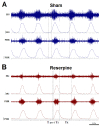Deficiency of Biogenic Amines Modulates the Activity of Hypoglossal Nerve in the Reserpine Model of Parkinson's Disease
- PMID: 33801475
- PMCID: PMC8001069
- DOI: 10.3390/cells10030531
Deficiency of Biogenic Amines Modulates the Activity of Hypoglossal Nerve in the Reserpine Model of Parkinson's Disease
Abstract
The underlying cause of respiratory impairments appearing in Parkinson's disease (PD) is still far from being elucidated. To better understand the pathogenesis of respiratory disorders appearing in PD, we studied hypoglossal (HG) and phrenic (PHR) motoneuron dysfunction in a rat model evoked with reserpine administration. After reserpine, a decrease in the baseline amplitude and minute HG activity was noted, and no depressive phase of the hypoxic ventilatory response was observed. The pre-inspiratory time of HG activity along with the ratio of pre-inspiratory time to total respiratory cycle time and the ratio of pre-inspiratory to inspiratory amplitude were significantly reduced during normoxia, hypoxia, and recovery compared to sham rats. We suggest that the massive depletion of not only dopamine, but above all noradrenaline and serotonin in the brainstem observed in our study, has an impact on the pre-inspiratory activity of the HG. The shortening of the pre-inspiratory activity of the HG in the reserpine model may indicate a serious problem with maintaining the correct diameter of the upper airways in the preparation phase for inspiratory effort and explain the development of obstructive sleep apnea in some PD patients. Therapies involving the supplementation of amine depletion other than dopamine should be considered.
Keywords: Parkinson’s diseases; biogenic amines; hypoglossal nerve; hypoxia; phrenic nerve; reserpine model.
Conflict of interest statement
The authors declare no conflict of interest.
Figures






Similar articles
-
Respiratory pattern and phrenic and hypoglossal nerve activity during normoxia and hypoxia in 6-OHDA-induced bilateral model of Parkinson's disease.J Physiol Sci. 2020 Mar 11;70(1):16. doi: 10.1186/s12576-020-00743-4. J Physiol Sci. 2020. PMID: 32160868 Free PMC article.
-
Impaired Breathing During Exposure to Hypoxia and Carotid Body Dysfunction in an Animal Model of Parkinson's Disease.Compr Physiol. 2025 Aug;15(4):e70035. doi: 10.1002/cph4.70035. Compr Physiol. 2025. PMID: 40757781
-
Respiratory activity in the 6-hydroxydopamine model of Parkinson's disease in the rat.Acta Neurobiol Exp (Wars). 2014;74(1):67-81. doi: 10.55782/ane-2014-1973. Acta Neurobiol Exp (Wars). 2014. PMID: 24718045
-
Retracted: Control of hypoglossal pre-inspiratory discharge.Exp Physiol. 2020 Aug;105(8):1232-1255. doi: 10.1113/EP087329. Epub 2020 Jul 16. Exp Physiol. 2020. Retraction in: Exp Physiol. 2020 Nov;105(11):1972. doi: 10.1113/EP089093. PMID: 32539192 Retracted. Review.
-
Molecular, Neurochemical, and Behavioral Hallmarks of Reserpine as a Model for Parkinson's Disease: New Perspectives to a Long-Standing Model.Brain Pathol. 2015 Jul;25(4):377-90. doi: 10.1111/bpa.12253. Epub 2015 Apr 22. Brain Pathol. 2015. PMID: 25726735 Free PMC article. Review.
Cited by
-
L-DOPA Improves Ventilation but Not the Ventilatory Response to Hypercapnia in a Reserpine Model of Parkinson's Disease.Brain Sci. 2023 May 8;13(5):775. doi: 10.3390/brainsci13050775. Brain Sci. 2023. PMID: 37239247 Free PMC article.
References
-
- da Silva Córneo E., de Bem Silveira G., Scussel R., Borges Correa M.E.A., da Silva Abel J., Luiz G.P., Feuser P.E., Silveira P.C.L., Machado-de-Ávila R.A. Effects of gold nanoparticles administration through behavioral and oxidative parameters in animal model of Parkinson’s disease. Colloids Surf. B Biointerfaces. 2020;196:111302. doi: 10.1016/j.colsurfb.2020.111302. - DOI - PubMed
MeSH terms
Substances
LinkOut - more resources
Full Text Sources
Other Literature Sources
Medical

